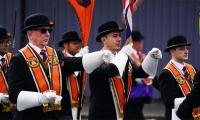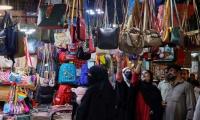LAHORE: Exactly six-and-a-half years after the Imran Khan-led Pakistan Tehreek-e-Insaf (PTI) had staged a fantastic rally at Lahore’s Minar-e-Pakistan on October 30, 2011, following years in the wilderness, this 22-year political party stunned its rivals Sunday evening by drawing a massive crowd at the 125-acre lush lawns of same venue, called the Greater Iqbal Park, formerly known as Minto Park.
Although PTI Chief Imran Khan had reached the venue by 9pm Sunday evening, thousands of his followers were still stuck up in traffic muddles on roads around the Iqbal Park. If the scale of the October 30, 2011 PTI rally was described as a “tipping point” for Imran Khan and his political entity by eminent Western media outlets like “The Telegraph,” last evening’s public meeting will certainly go a long way in rejuvenating and revitalizing Imran Khan and his lieutenants ahead of the 2018 general elections.
The Minto Park was named after Lord Minto Gilbert Elliot (1751-1814), the Ninth Indian Governor General between 1807 and 1813. The vast grassy stretches around the Minar-e-Pakistan are more famous for hosting the All-India Muslim League’s gathering that had passed the March 23, 1940 Pakistan Resolution—-the event that had provided the decisive impetus to the movement leading to the division of British India in 1947.
The 203-foot high Minar-e-Pakistan tower was hence built between 1960 and 1968 at the Greater Iqbal Park to commemorate the first official call for a separate homeland for the Muslims of India.
This monument was completed on October 21, 1968 at an estimated cost of Rs7,058,000 (over Rs7 million). The money was raised by imposing an additional tax on cinema and horse racing tickets at the demand of Akhtar Hussain, the-then Governor of West Pakistan.
Renovated over a period of 13 months by the incumbent Punjab government with a cost of Rs981 million on November 9, 2016, the Greater Iqbal Park is surrounded from all sides by the 13 gates of the centuries-old Walled City that happens to be the cultural heart of Lahore.
This park was also the venue for the mammoth reception accorded by the Laborites to late Pakistani Premier Benazir Bhutto on April 10, 1986 upon her return from a long exile in Europe. The inaugural function of former President General (retired) Pervez
Musharraf’s Referendum was also held at the Minar-e-Pakistan in April 2002. The 44-party Pakistan Defence Council, an umbrella group of 44 right-wing entities and personalities, had also held a successful rally at this particular venue in December 2011, whereby a resolution to defend the country against external aggression was passed.
Headed by the Jamaatud Dawa Chief, Hafiz Saeed, this rally was viewed by Indian and Western media as a gathering of jihadists, sectarian warriors, orthodox mullahs and Islamic revivalists.
Interestingly, on April 25, 2010, the MQM had planned to hold a party convention at Minar-e-Pakistan for its Punjab-based workers, but was denied permission by the authorities at the helm of affairs.
The Greater Iqbal Park, which features ample seating and artistic food courts like “The Poet” and shopping kiosks for visitors, has thus witnessed nearly every political entity like the All India Muslim League, the Khaksar Tehreek, the incumbent PML-N, the Pakistan People’s Party, JUI-F, Pakistan Awami Tehreek, the MQM and the General Musharraf-led PML-Q etc holding widely-attended corner meetings during the last 78 years or since March 23, 1940—but the one hosted by the PTI last evening will perhaps go down in history as the biggest of all rallies held here!
Situated adjacent to the Greater Iqbal Park are the tombs of great spiritual thinker, Allama Iqbal, and Hafeez Julandhari, the poet who wrote the lyrics for the National Anthem. Great Iqbal Park Lahore is also famous for breeding innumerable Cricketing gems.
Along with Pakistan’s Cricket legend Fazal Mahmood (1927-2005), with whom American actress Ava Gardener (1922-90) had requested to dance and whose fans included former Indian Premier Indira Gandhi, numerous Indian and Pakistani cricketers like Lala Amarnath, Abdul Hafeez Kardar, Imtiaz Ahmed, Nazar Muhammad, Mudassar Nazar, Saleem Malik, Saleem Pervaiz, Sarfraz Nawaz, Shafqat Rana, Azmat Rana, Javed Burki, Majid Khan, Imran Khan himself, Zulfiqar Ahmed, Shuja-ud-Din, Amir Elahi,Gul Mohammad, Dr Dilawar Hussein, Ameer Hussain, Maqsood Ahmed and sub-continent’s quickest fast bowler of the time, Muhammad Nisar, etc. had polished their skills on these grounds.
Research reveals that on May 28, 1950 and later in 1956, the fiery speeches of famous mathematician and political theorist, Allama Inayatullah Khan Mashriqi (1888-1963), had attracted large crowd at this venue too.
Allama Mashriqi had established the “Khaksar Tehreek” in 1930 and within years, it had emerged as the most organized movement in the history of India. History shows that on March 19, 1940, or just four days before the March 23, 1940 Pakistan Resolution was passed at Minto Park, a clash had occurred between the 313 Khaksar workers and the Police in the nearby Heera Mandi Bazaar where an England-born Assistant Superintendent of Police was killed.
The Khaksar Tehreek’s Lahore headquarters were consequently raided, resulting in arrests of many Khaksars. During the raid, Allama Mashriqi’s son, Ehsan Ullah Khan Aslam, was fatally injured by a tear gas grenade hurled by the police.
Ehsan Ullah Khan later succumbed to his head injuries. At the time of Ehsan Ullah Khan Aslam’s death, Mashriqi was in Madras Jail and was not allowed to attend the funeral of his young son.
Allama Mashriqi then wrote a poem in memory of his son in his book “Hareem-e-Ghaib.” A hell was let loose thereafter by the rifle-trotting policemen, causing death to over 50 young followers of the jailed Allama Inayatullah Khan Mashriqi.
In his book “Jinnah faces an assassin,” noted Indian barrister, philanthropist and educationist Akbar Peerbhoy had revealed that on July 20, 1943, Quaid-e-Azam Muhammad Ali Jinnah had escaped an assassination attempt launched by one Rafiq Sabir, who was assumed to be a Khaksar worker.
The life attempt was condemned by Allama Mashriqi. Later, Justice Blagden of the Bombay High Court, in his ruling on November 4, 1943, had dismissed any association between the attack and the Khaksar Tehreek leadership.
K.L. Gauba (Member Indian Legislative Assembly) wrote in his book “Friends and Foes” (page 204) that according to eye witnesses the number of dead was more than 200.
Eminent historian Qutubuddin Aziz writes: “Khaksars were mesmerized into becoming followers of the Quaid-i-Azam and were performing security duties to protect the giant Muslim League pandal (canopy) in the Minto Park, the venue of the Muslim League’s session in Lahore. The Quaid-i-Azam had issued press statements condemning the Punjab police firing of April 19, 1940 on the unarmed Khaksars and urged the coalition ministry of Sir Sikander Hayat Khan who was the then Chief Minister of Punjab, to pay compensation to the bereaved families and to punish the officers who ordered the police firing.”
He further writes: “The Quaid-i-Azam had then urgently summoned Nawab Bahadur Yar Jung from Hyderabad Deccan to use his good offices for placating the chief of the Khaksars to help maintain peace in Lahore during the Muslim League’s session. The Quaid’s visit to the Mayo Hospital to console the bereaved families of the Khaksars had a magical effect on Lahore’s political atmosphere and groups of Khaksars trekked to the Minto Park and took oaths to safeguard the pandal and protect the Muslim Leaguers in Minto Park. It was an incredible change of political weather in Lahore.”
Plea was filed by Amir Nawaz Warraich, President of Karachi Bar Association under Article 184 of Constitution
Tariq Fatemi says there is something fascinating about Pakistan-China ties that has puzzled scholars for years
Saudi Airlines to provide travel facilities for 35,000 Pakistani govt Hajj pilgrims to and from Saudi Arabia, says...
Atta says, "We reiterate our full support and confidence in the esteemed members of the JCP"
Noor Islam says that killers had also broken locks of cupboards and stolen two tolas of gold jewelry and Rs50,000 in...
PHC grants transit bail to MNA Shahram Tarakai and his brother and KP Minister Faisal Tarakai







